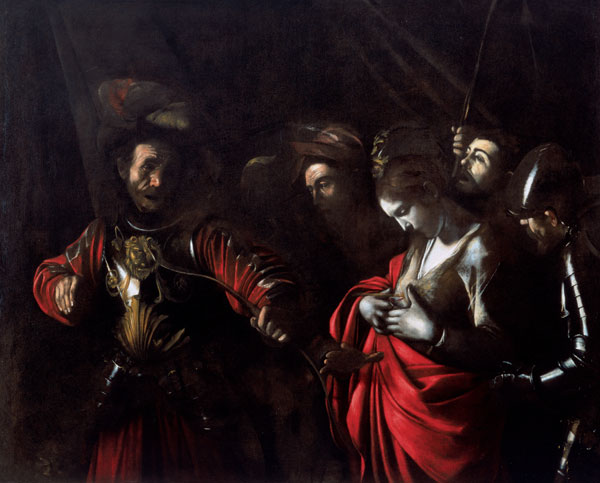
Caravaggio, The Martyrdom of Saint Ursula, credit wikipedia
The Last Caravaggio
Francesca Whitlum-Cooper, National Gallery Global, London, 2024, the catalogue of the exhibition The Last Caravaggio at the National Gallery, 18th April-21 July 2024, reviewed by Leslie Jones
According to Giovanni Pietro Bellori, one of Caravaggio’s three seventeenth century biographers, some of his younger, fellow artists considered him “the unique imitator of nature”. Yet more conservative commentators, including Bellori himself, disdained paintings of figures that were “so drastically unidealized”, as compared with the works of Raphael and Michelangelo.[i] Indeed, it was Caravaggio’s “extreme fidelity to the world around him” that was considered by some as “mechanical, uninformed and even unworthy”.[ii] John Ruskin, that Victorian arbiter of taste, made some scathing comments about the artist. Following a visit to the Louvre, on 8th September 1849, Ruskin wrote the following entry in his diary,
Kingliness and Holiness and Manliness and Thoughtfulness were never by words so hymned or so embodied or so enshrined as they have been by Titian and Angelico and Veronese – so never were Blasphemy and Cruelty and Horror and degradation and decrepitude of intellect – and all that has sunk or will sink Humanity to Hell – so written in words as they are stamped upon the canvases of Salvator and Jordaens and Caravaggio and modern France.
What was Ruskin’s beef? His ideal of art, as the diary entry suggests, was ultimately religious and moralistic, somewhat akin to JH Newman’s conception of education at its best. Ruskin described the beautiful in art as “a gift of God”.
In Dr Whitlum-Cooper’s expert opinion, the “discomfort” caused by Caravaggio’s influence on art “goes a long way to explaining why Caravaggio was largely forgotten in the eighteenth and nineteenth centuries”.[iii] Ruskin, for one, was doubtless offended by Caravaggio’s “sensual portrayals of young men, in conjunction with a lack of erotic female characters in his work” (see Caravaggio, in The Art Story). Likewise, by the “penetration of the Hun’s arrow”, in The Martyrdom of Saint Ursula and the blood gushing from the wound, which had what the author calls “an unavoidably sexual connotation”. [iv] Effie Gray stated that the reason why Ruskin “did not make me his Wife” (i.e. why he failed to consummate the marriage) was “because he was disgusted with my person the first evening 10th April (1848)”. Menstruation, or body odour, or pubic hair may have caused Ruskin’s disgust. Apropos Ruskin’s alleged paedophilia, perhaps what he “most valued in pre-pubescent girls was…the fact that they were not (yet) fully sexually developed” (see Caravaggio, The Art Story).
According to one school of thought, a bad person cannot be a good painter. And as Guardian art critic Jonathan Jones reminds us, Caravaggio was bibulous, irascible and prone to violence. He was regarded as “a streetfighter, a killer…but not an intellectual” (‘The Last Caravaggio review – a gripping and murderously dark finale’, 16 April). Jones emphasises the (projected?) fury of the rebuffed Hunnish king in The Martyrdom of Saint Ursula. Here, he concludes, is “a dumbfounding drama of rage, violence, death…”. Violence and death are recurrent themes in the artist’s late work, as in The Beheading of John the Baptist and Resurrection of Lazarus (see Jonathan Jones, ‘Who killed Caravaggio and why’, Guardian, 12 April). More evidence, for his detractors, of what Bellori called his lack of “invention, decorum, disegno”.
In 1876, the Academia in Venice allowed Ruskin to place Vittore Carpaccio’s Dream of St Ursula (1876) in a private room so that he could make a copy. In Carpaccio’s painting, an angel appears in a dream to tell the saint of her impending martyrdom but to assure her that she will be welcomed in heaven. It seems that Ruskin, now losing touch with reality, identified Saint Ursula with his former pupil Rose La Touche. Ruskin was convinced that Rose, who had died in 1875, was sending coded messages of consolation through the painting.[v]
We commend Dr Whitlum-Cooper’s splendid introduction to Carvaggio’s life and work.
Endnotes
[i] Francesca Whitlum-Cooper, The Last Caravaggio, p 13
[ii] Ibid., p 13
[iii] Ibid., p14
[iv] Ibid., p 27
[v] See Leslie Jones, ‘Chiaroscuro – Ruskin in darkness and in light’, Quarterly Review, Spring 2012









Ruskin, Arnold, Morris, Galton, Kipling, Brunel, Newman, Mill – all “eminent Victorians” in many ways. Synthesise their best ideas if we want recovery.
OK, there was Jack the Ripper, and the workhouse.
But what have we today? Graffiti, drill, polyamory, sick-notes, pedo-porn, freakery, telly trash, gang crime, aid for China, aircraft carriers without aircraft, legs not brains, little boats and big drugs, foreign ownership of nearly everything, out of Empire and out of Europe (except for Ukraine), with government debt equivalent to a mere 97% of the GDP.
Galleries, museums, libraries, schools, theatres, publishers, churches and charities totally “woked”.
Judi Love and Danny Dyer, RuPaul and Prince Andrew, Ncuti Gatwa and Lenny Henry, Rosie Jones and Eric Pickles, Paula Vennells and William Wragg, Sudesh Amman and Mohamed Mansour, Ed Davey and Justin Welby – the Ghastly Gallery of Gruesome Grocks, looking for the best deckchairs on the Titanic of Tripe
A century or so ago Edgar Wallace wrote a literary bestseller “The Four Just Men”.
Today perhaps someone should write a Netflix blockbuster in support of all 21 genders celebrated by the NHS North Midlands University Hospitals (Daily Mail, April16), entitled “Four Only Just Men”, possibly starring exemplary national treasures like Suzy Izzard, Grayson Perry, Layton Williams and Richard Coles. The BBC Kids Charity that funds transition surgery could finance it, and Graham Norton could make TV (sic) comeback splash (sic) with it.